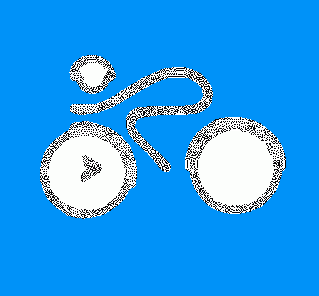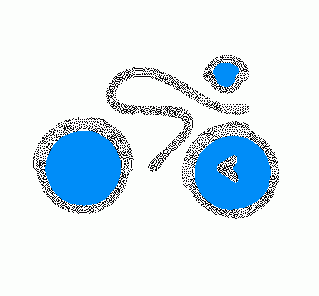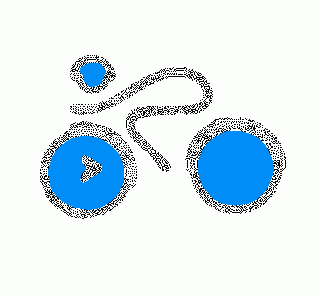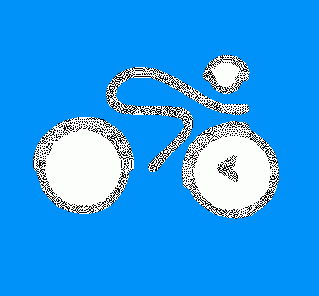| Newsletter - 2004 Archive |

|

|
Cycling Club |

|

|
| Newsletter - 2004 Archive |

|

|
Cycling Club |

|

|
Next--->
|
A Different Perspective on Ride
Day: Whenever I leave home to ride a randonneuring event, among those affected by my absence is someone who for years has remained faithful, patient, and understanding: my cat. It's nice to know that I am missed when I'm off somewhere racking up the kilometers, but at the same time there is always that mild twinge of guilt that sits lightly in the chest and must somehow be made up for at a later date. Thus it was that I discovered a marvelous way to be involved in a rando event yet still give full attention to those not involved in, but still affected by, my cycling predilection - volunteering to help out on ride day. The night before a ride is always a bit tense for me as I review the route, double and triple check my bike, assemble my gear, visit and re-visit the Weather Channel, eat a big meal, lay out my clothing, set my alarm, and worry about whether or not I'll fall asleep quickly enough to be properly rested for the next day. All of these pressures, however, vanish like Ken Bonner into the early morning mist when one knows that the next day will involve nothing more strenuous than signing control cards and offering encouragement. So, the night before the LM 400 was much like any weekend evening: my girlfriend came over for dinner; we attended a modern dance performance, and then back to my place for the night. Granted, she was a bit non-plussed at having to get up and go home at 4:00 AM when my alarm went off, but that was counter-balanced by my cat's being totally delighted at getting fed two hours earlier than normal. The starting point for the LM 400 was at Broadway and Boundary which is fairly close to where I live, so I cycled over at around 5:00 AM and found Harold sitting in his pick-up waiting for the show to begin. Michel and Karen arrived shortly thereafter and we quickly set up shop in preparation for the arrival of les cyclistes. Michel proved quite capable at putting the Division of Labour theory into practice and so it was that we were assigned tasks and quickly created a production line that would have made Henry Ford envious: Harold did the bike check, Michel collected the money, Karen and I handed out control cards and route sheets. Twenty-seven riders arrived, signed in, and were duly registered. The best part of this process for me was that I got to put faces to names. Like so many people, I'm "terrible at names", but the experience of greeting all the riders that morning, writing down their names, and handing them their control cards and route sheets helped me ascertain people's names without that awkward, embarrassing moment where one says to someone: "Forgive me, but I can't remember your...." Shortly past 6:00 AM, Michel gave his oration to the troops in proud, encouraging Henry V style; Shakespeare couldn't have written a better speech. Among the various pieces of last-minute advice, he warned them of the hazards of getting onto the Patullo Bridge, a situation that had warranted a conference one week earlier on the pre-ride. We had stopped on the north end of the bridge (Michel, Karen, and I), turned back to look at the confusing, possibly dangerous, lanes of traffic and considered advising riders to cut across to the bike path. Which was the safest way to approach the bridge? Which was legal? Was there a liability issue? Questions I had never before considered had now become something into which I had input and therefore responsibility. This business of volunteering was not just performing mundane tasks that would insult the intelligence of mouth-breathing simians, but was rather about looking out for the best interests of those that would depend on the accuracy of the information provided on the route sheet so that they would have a safe, sane, and rewarding journey. I felt honored to be a part of the process. At 6:04 the riders zipped away amidst the click and clatter of cleats snapping into pedals and shifting gears. As the throng of randos cornered past the McDonald's and quickly disappeared from view, I felt a strange relief that I did not have to ride today. The 200, 300, and 400 pre-ride had taken up three of the previous four weekends for me, and my legs were telling me that it was time for a bit of a breather. "Don't stop riding", they said, "Just don't ride quite so far this weekend." I heeded my leg's wishes, and chose to ride only from the Abbotsford control back to Vancouver after having signed all the riders through. Michel gave me and my trusty bike a ride to the Chevron on Highway 11, and there I waited for the first riders to appear. Naturally, Keith Fraser was the first to arrive along with Rob Bitzer. Keith had taken a tumble when his wheel touched Rob's, and I noticed a bit of a scrape on his leg. I've been very lucky over the years and have rarely had to dig into the first aid kit I carry in my seat-bag, but now I had the opportunity to assist a fellow rider. I gave Keith an alcohol swab and bandage for his abrasion, thought momentarily about Florence Nightingale, figured I'd look ridiculous dressed like her, then shouted, "Good luck!" as Keith and Rob hurtled themselves out of the control. Not long after, a trio of riders appeared, one of which was Eric Fergusson. Having chased after Eric in the previous couple of rides before he unceremoniously dropped me like a sumo wrestler on a unicycle, I was quick to point out that today, for the first time ever, I had arrived at a control before him - a cheap shot, but I'll take it nonetheless. Over the next two hours, riders arrived and departed in two's, three's, and small swarms. Signing their cards gave me an opportunity to reiterate the faces-to-names exercise I had gone through at the start. I managed to exchange a few friendly words with each of the riders before they departed, many of them calling out a cheery, "Thanks, Kevin!" as they left. And so it was that I realized yet another benefit to volunteering: not only was I putting a name to each face, but they were putting a name to mine. Shortly before the control closed at around 10:00 AM, Karen and Harold arrived unexpectedly; they were on a quest for food to take with them to the Toll Booth control. Their timing was excellent as I had been wearing a fleece jacket that I really didn't want to wear on my ride back to Vancouver. I asked if I could leave my jacket with them to be brought back to the Knight & Day later that evening, and Karen was quite pleased at the thought that an extra fleece might come in handy in the thin mountain air where she was headed (it did, too, so she told me later). After the last rider was duly signed through the Abbotsford control, I climbed on my bike, headed back to the city, and stopped to replenish carbohydrates in Surrey by wolfing down a Dutch Pannekoek the size of planet Jupiter. When I arrived home at around two o'clock, the cat looked up from her basket, a bit surprised that I was home so soon and would have checked her watch had she been wearing one. After convincing her that, no, it was not yet time for her to eat again, I flopped down on the couch and switched on the TV and to watch the Preakness Stakes, the 'second jewel' in horse racing's Triple Crown. The cat flopped down on my belly and, through an exchange of various 'meows', engaged me in a conversation the meaning of which will forever be known only to her. I watched in amazement as a horse named 'Smarty Jones' demolished the rest of the field in the Preakness the same way that certain randos finish brevets in freakishly fast times. It was now about 3 o'clock in the afternoon and even though I felt the urge to sleep for a bit, I still felt slightly anxious about being part of the ride that was now going on without me. I had promised to be at the closing control at 8 o'clock, but now had about five hours to kill where I didn't quite know what to do with myself besides catch a nap. Given the time of day, I figured that most riders would be on the Coquihalla by now and I remembered the Coquihalla webcam that is available for viewing through the Ministry of Transport's website. I went to the computer, opened my browser, and searched all the different camera shots hoping to find randos in action as they struggled up and coasted back down the Coquihalla. The cameras take only still photos at half-hour intervals and there appeared to be nothing of interest on any of them except for a few curious specks on the side of the road in a shot taken from the snow shed. I saved this photo, and a half hour later saved the next one. Comparing the two I could see that the specks that had been on the side of the road were no longer there, but there was now a new set of specks a bit further up the road and on the other side. Whatever these specks were, they were moving, and this could mean only one thing: they were randos caught by the Coquihalla webcam! Satisfied that I had captured something truly unique, I crawled into bed to rest up for the long night ahead. After managing a few winks of sleep, I leapt from my bed at the crack of dusk, fed the cat, hopped on my bike and headed down to the Knight & Day. After taking a table and ordering fish and chips, Michel arrived and shortly thereafter Lyle joined us. Michel and Lyle had club business to discuss, so I attempted to split the difference between ignoring them and respectfully acknowledging their need to talk by occasionally glancing at the newspaper I had brought with me. They discussed membership fees; they discussed insurance matters; they discussed routes; they discussed the need to encourage more people to volunteer; they discussed the need for more copy for the newsletter. After about an hour of exhausting the various matters at hand, there was the sort of lull in the conversation that signaled the end of their discussion. They had identified and defined the issues of importance that would need to be further addressed. At this point, I folded my newspaper, set it down, looked at Lyle and said, "So, you need copy for the newsletter," then, turning to Michel, said, "and you need more people to volunteer." Both nodded. "Well," I continued, "why don't I kill two birds with one stone and write an article for the newsletter about volunteering?" Michel smiled and said, "I was hoping you'd say that." He's a sneaky one, that Michel. No wonder he's the President. Shortly past 9:00 PM, the first finishers rolled in and to no one's surprise it was Keith Fraser accompanied by US import Chris Copeland. How they managed to cover 400 km to the toll booth and back in just over 15 hours without taking a bus, I'll never know, but there were the duly signed control cards, dirt on their faces, and sweat on their brows to prove the veracity of their claim. At around 11:00 PM, Karen appeared, back from duty at the toll booth. She warned of many riders not looking in very good shape by the time they had gotten to the Toll Booth control just past the summit. How they would look upon completing the entire distance was anyone's guess. Matthew Campbell appeared at around 11:30, and just past midnight Eric Fergusson and Susan Barr rolled in. At this point, I wondered if it was more than just coincidence that three of the five fastest finishers - Fraser, Campbell, and Fergusson - have distinctly Scottish names. As the night wore on and our eyelids became progressively heavier, the riders trundled in throughout the night and we offered congratulations and a polite smattering of applause whenever we found the energy. Our little production line continued to work efficiently, albeit somewhat more slowly than at sign-up that morning. I dutifully recorded each rider's final time and stamped their cards, Karen handed out the pins, and Michel verified the times with his signature. Karen pointed out that none of the riders looked nearly as haggard at the finish as they had upon reaching the toll booth. There is something about cycling up a mountain to its summit that gives one pause to question one's own sanity, which is what Karen witnessed at the Toll Booth. Such self-doubt vanishes, however, when one feels the surge of satisfaction at completing the ride, and that's what we witnessed at the final control. Some riders joined us at the table, though not so much for the conversation as for the opportunity to sit down without having to move their legs in a circular motion. A few of the riders were so tired and hungry they finished off the pizza I had ordered earlier and could not finish myself. I didn't bother to tell them that the pizza was about six hours' old, but even if I had I doubt it would have made any difference to them. At 6:00 AM, with only two hours' to go until the final control closed, there were but two riders still to come in: Barry Bogart and Margaret Elliott. Barry had with him one of those GPS things and he had given Karen the website and code so that we could track their progress. I suggested that since I lived close by I go home, determine their location, and then call Karen on her cell phone to let her and Michel know how much longer they'd be. This, of course, was just a sneaky way of getting to bed a little earlier than if I were to stick around. Seeing as Michel had already gotten me to write this article you're now reading I knew I wasn't fooling him with this ploy, but it worked nonetheless. I hopped back on my bike and pedaled home. After feeding the cat an extra half-scoop of her favorite kibble, I switched on the computer, found the GPS website, punched in the code, and determined that Barry and Margaret were currently at the start of the Mary Hill bypass. I phoned Karen and told her that the last two riders should be there in about an hour. After the obligatory but heartfelt "Thanks for everything," and "have a good sleep", I hung up, got undressed, and climbed into bed as the cat leapt up onto the duvet and snuggled in beside me. As I lay in the quiet, reflecting on this first time experience as a ride day volunteer, I thought about all the previous rides I had ridden and how there was something about each ride that made me think that certain things could have been done differently. There can be curious choices for controls or strange routings that don't quite make sense; maybe the starting point is a bit awkward to get to at an early hour, or perhaps there might be points along the route that require particular caution that I wish I had known about in advance. In such cases, it is perfectly normal for one to recognize (or think they recognize) a better way of doing things, and articulate one's thoughts by saying something that begins with the words, "What they should do is..." But who are "they"? And will "they" ever listen? How does one influence this relatively anonymous entity referred to as "they"? Now I had my answer: the best way to ensure that "they" make irreproachable decisions is to become one of them. Kevin Bruce _ |